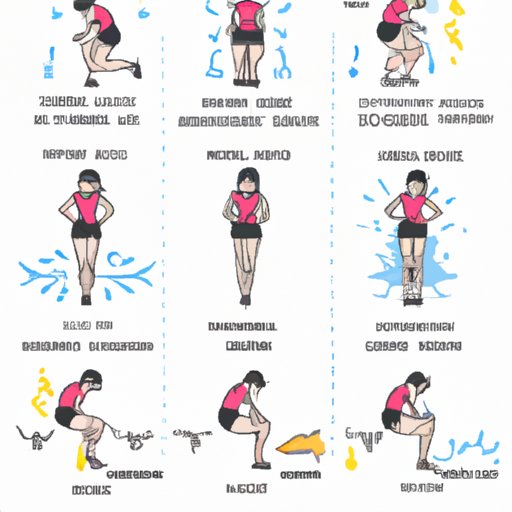Introduction
Spotting and cramping are two common symptoms associated with the menstrual cycle. Spotting is a light vaginal bleeding that occurs outside of a period, while cramping refers to abdominal pain or discomfort that may occur before or during menstruation. Although these symptoms are generally considered normal, they can be uncomfortable and disruptive to everyday life.
In this article, we will explore the potential link between exercise and spotting/cramping. We will examine the evidence for this connection, investigate the potential causes of spotting/cramping during exercise, and analyze the role of hormones in spotting/cramping after exercise.
Examining the Link Between Exercise and Spotting/Cramping
The relationship between exercise and spotting/cramping is not well understood. However, there is some evidence that suggests that certain types of exercise can cause spotting/cramping, particularly when done in excess. For example, one study found that women who engaged in vigorous exercise five or more times per week had almost twice the risk of experiencing spotting compared to those who exercised less.
It is important to note that the impact of exercise on spotting/cramping may vary depending on the type and intensity of the activity. For instance, one study found that high-intensity interval training (HIIT) was associated with an increased risk of spotting, whereas moderate-intensity aerobic exercise was not.
Exploring the Potential Causes of Spotting/Cramping During Exercise
There are several potential causes of spotting/cramping during exercise. It is possible that intense physical activity or a sudden increase in intensity could trigger spotting/cramping. Additionally, low body fat or dehydration could also contribute to spotting/cramping.
Hormonal imbalances may also be a factor. While exercising regularly can help reduce stress hormones like cortisol, it can also disrupt the balance of other hormones such as estrogen and progesterone. This disruption may lead to changes in the menstrual cycle, including spotting/cramping.
Investigating the Effects of Intense Exercise on Menstrual Cycle Health
Intense exercise can have a significant impact on hormone levels, which can in turn affect menstrual health. One study found that extreme endurance athletes (those who exercise for more than four hours per day) were more likely to experience irregular periods and amenorrhea (the absence of menstrual periods).
Amenorrhea has been linked to an increased risk of infertility, bone loss, and other health issues. Therefore, it is important for athletes to be aware of the potential risks associated with intense exercise and to discuss any concerns with a healthcare provider.
Unpacking the Pros and Cons of Exercising with Spotting/Cramping
Exercising despite spotting/cramping can be beneficial in some cases. Regular physical activity can help relieve stress, improve mood, and boost overall health. Additionally, it can be an effective way to manage cramps, as exercise helps to increase blood flow to the uterus and pelvic area.
However, it is important to consider the risks associated with exercising with spotting/cramping. Prolonged or excessive exercise could potentially worsen spotting/cramping, as well as lead to other health problems. It is always best to consult with a healthcare provider before continuing with exercise if you experience spotting/cramping.
Analyzing the Role of Hormones in Spotting/Cramping After Exercise
Hormones play an important role in regulating the menstrual cycle and can be affected by exercise. High levels of estrogen and low levels of progesterone can lead to spotting/cramping, as can fluctuations in other hormones such as testosterone and luteinizing hormone (LH).
Hormonal treatments, such as oral contraceptives or hormone replacement therapy, may be beneficial for managing spotting/cramping after exercise. It is important to consult with a healthcare provider to determine the best course of action for your individual needs.
Conclusion
In conclusion, there is evidence to suggest that certain types of exercise can cause spotting/cramping, and that intense physical activity or a sudden increase in intensity may be the cause. Additionally, hormonal imbalances can contribute to spotting/cramping after exercise. It is important to weigh the pros and cons of exercising with spotting/cramping, and to consult with a healthcare provider if necessary.


